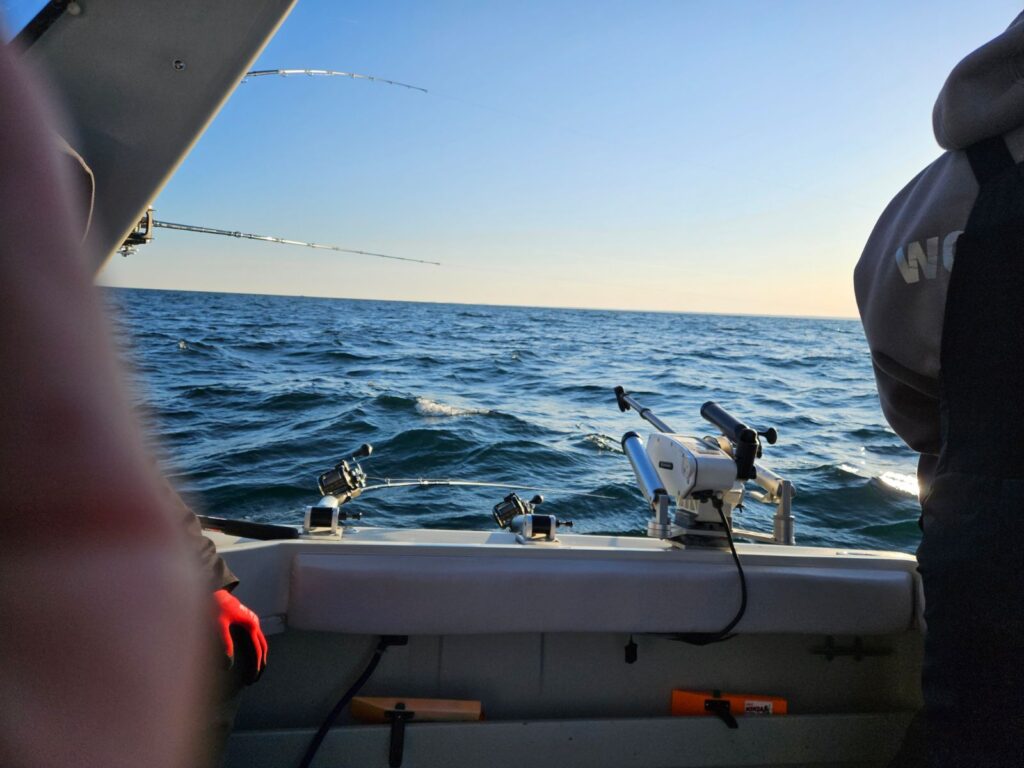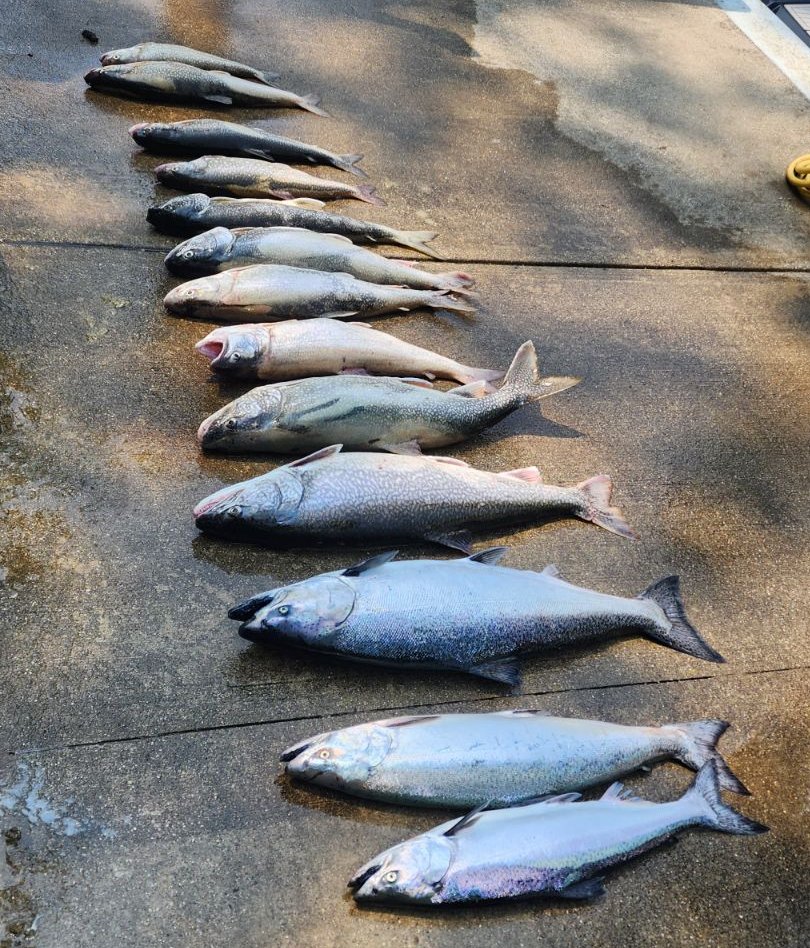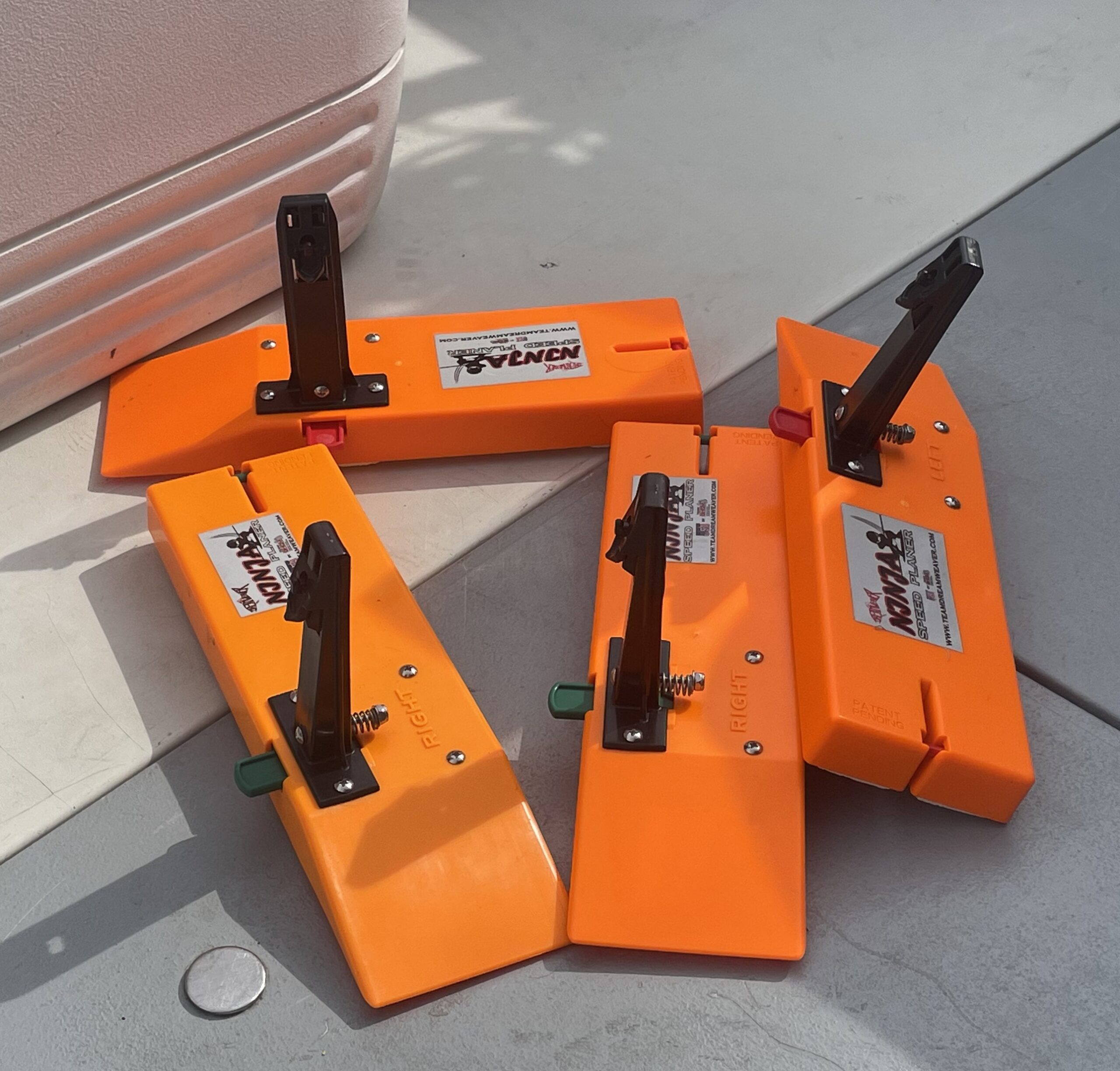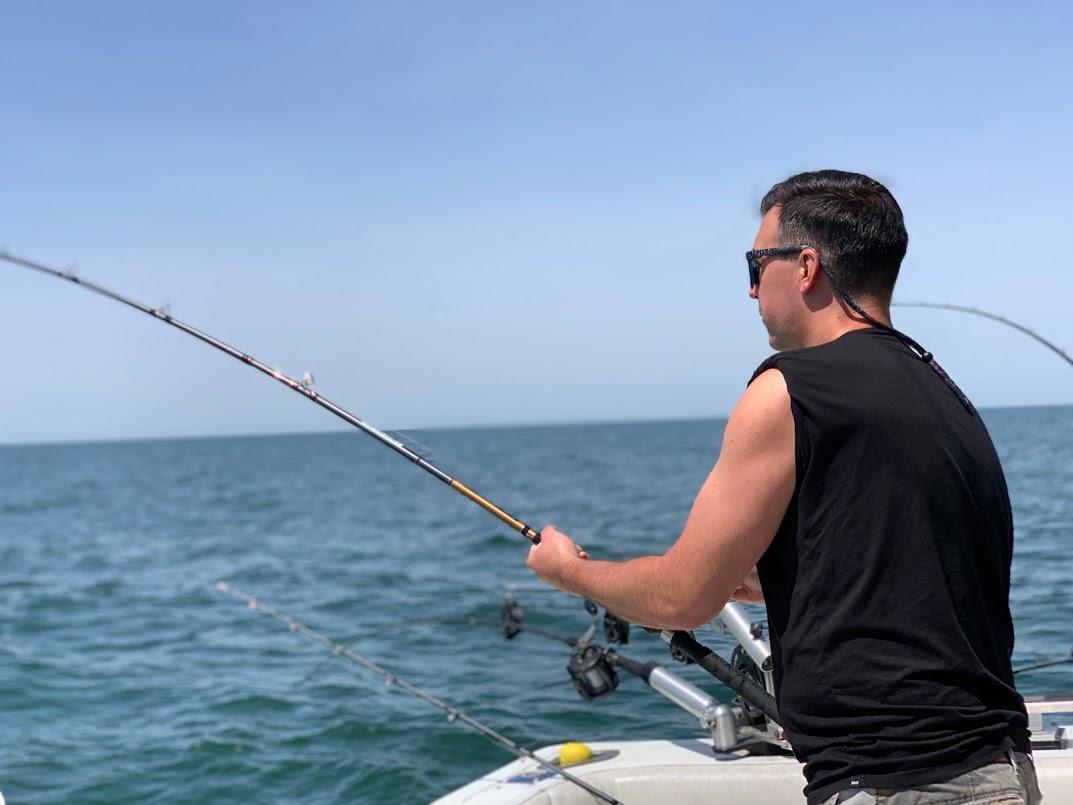If you’re considering booking a charter salmon fishing trip on Lake Michigan out of Saugatuck, Michigan, one of the most common questions you’ll ask is: When is the best time to fish? The short answer? There’s great salmon fishing to be had from April through September—but the species you’ll target, the techniques you’ll use, and even how deep you’ll be trolling will evolve throughout the season.
At our Saugatuck charter operation, we fish all season long and adapt our strategies as conditions change. In this post, we’ll walk you through the best months for salmon fishing, break down what’s biting when, and explain how our trolling methods evolve through spring, summer, and early fall.
April: Cold Water, Coho Action
As Lake Michigan thaws in early spring, the action begins in earnest. April marks the unofficial start of the salmon season, and while water temps are still frigid (often in the 40s), one species loves these early season conditions: coho salmon.
What to Expect
Coho are aggressive feeders and tend to school in the shallower, warming waters near shore. Out of Saugatuck, we often find them in 10 to 40 feet of water, typically south of the pier heads or just outside the river mouth.
This is also a time when brown trout and lake trout may be caught while targeting coho, adding variety to your cooler.
Trolling Techniques
Trolling speeds are slower—around 2.0 to 2.3 mph—because of the cold water. We often run small orange or red spoons, stickbaits, and thin trolling flies behind planer boards to spread out the presentation. Short lead cores or even flat lines work well this time of year, and it’s not unusual to have double or triple hookups when the cohos are thick.
May: Mixed Bag and Moving Offshore
As May rolls in, water temperatures slowly rise, and more of Lake Michigan’s sport fishery comes to life. This is when the kings start to show up, mixing with coho, steelhead, and lake trout.
What to Expect
By mid-May, the coho salmon start moving deeper, and king salmon (Chinook) begin appearing in larger numbers, particularly on warmer years. We’ll troll from 40 to 100 feet of water depending on conditions, and start seeing more diversity in the catch.
This is also when steelhead start to cruise the top of the water column, offering acrobatic fights that make them fan favorites.
Trolling Techniques
We begin incorporating more lead core and copper lines to reach deeper depths. Downriggers and divers come into play as we start targeting mid-water fish. Larger spoons, meat rigs, and flasher/fly combos start becoming effective, especially for kings.
Planer boards are still essential, but spreads become more complex as we cover multiple depths. Speed can be increased slightly—around 2.2 to 2.6 mph.
June: Kings Are Here
June is a transition month where things really start to heat up—literally and figuratively. Surface temps climb into the 50s and 60s, and king salmon begin to dominate our catches.
What to Expect
June can bring some of the best big-fish action of the season. Chinook in the 10-20 lb range become more common, with some bruisers pushing past 25 pounds. You’ll also still catch a mix of steelhead and coho, with the occasional lake trout near bottom.
Thermoclines begin to form—this is the point in the water column where temperature drops rapidly and where salmon often stack. Locating the thermocline becomes key to success.
Trolling Techniques
This is when our full spread gets serious. We deploy a variety of tools—downriggers, Dipsy divers, long lead core, copper lines, and deep-set planer boards. Flasher/fly combinations in green, blue, and chrome shades dominate, though spoons and meat rigs still work well, especially for kings.
We start fishing in the 80-150 foot depth range, and focus on thermocline depth—usually 50 to 80 feet down.
July: Peak Salmon Season
July is when king salmon fishing peaks, and if you’re looking for action, size, and consistent limits, this is the month you don’t want to miss.
What to Expect
By mid-July, mature Chinook are feeding heavily as they prepare for their August/September spawning run. We fish deeper water (120–180+ feet) but often target depths from 60 to 100 feet down.
Steelhead and coho are still around but tend to stay higher in the water column or in slightly warmer water. Lake trout, meanwhile, hang near bottom and offer steady action for those who want to bottom bounce.
Trolling Techniques
This is big-boy trolling season. We use full 300+ foot copper lines, 10-color lead cores, deep Dipsy divers, and downriggers set 80-100+ feet deep.
Speed and depth control become crucial, and we use temperature probes and sonar to locate the thermocline precisely. Bait selection leans toward meat rigs and large flasher/fly combos in white, green, and UV patterns. Scent attractants become helpful for enticing strikes from wary salmon.
A big king will scream line off a reel and test your arms and your gear. Expect battles that last several minutes—and smiles that last much longer.
August: Monster Kings and Early River Moves
August is big fish month. The kings you’ll catch now are fully mature and on the move toward spawning tributaries—including the Kalamazoo River right here in Saugatuck.
What to Expect
This is the best month to catch your biggest Chinook salmon. Fish in the 20-30 lb range are common, with occasional 35+ lb trophies landed each year. Some salmon begin staging near the river mouth, while others are still feeding out in deeper water.
Steelhead and lake trout are still present but play second fiddle to the kings.
Trolling Techniques
In early August, we’re still fishing offshore in 100–160 feet of water. By late August, we often move shallower—50 to 100 feet—especially near the river mouth or pier heads. This is staging season, and salmon become more aggressive but also more finicky.
Meat rigs really shine now, often fished slowly behind big flashers. Glow patterns work well early in the morning or on overcast days. Wire Dipsy divers, deep copper lines, and riggers are the workhorses of August.
The fights are intense. Hook up with a staging king and prepare for a 15-minute tug-of-war.
September: Shoreline Fireworks
September fishing out of Saugatuck is unique—many kings enter the river system to spawn, but many still linger just offshore. This can lead to phenomenal pierhead trolling, especially for customers who prefer shorter boat rides but still want action.
What to Expect
This is the best month for nearshore, high-intensity king salmon action. The fish are darker in color and may not be as prime for eating, but they fight harder than ever as they prepare to spawn. Most are males, and they are aggressive.
Steelhead start making a bit of a comeback, and lake trout are still available in deeper water.
Trolling Techniques
Trolling right outside the river mouth or along the shoreline becomes the main tactic. We often fish in just 20 to 60 feet of water using short lead cores, divers, and flat lines.
Bright spoons, J-plugs, and glow baits excel now, particularly early in the morning or at dusk. Troll speeds slow down again, often around 2.0 mph or slower.
This is also a great time for new anglers or families, as the short runs mean more time fishing and less time cruising.
October: End of the Run
While our charter season typically winds down in September, there can still be fishable action into October—particularly for those who want to target steelhead or chase a few late kings.
What to Expect
Most Chinook salmon have entered the rivers or are finishing their spawn. The pierheads and river mouth may still offer some bites, but many of the kings are spent.
However, fall steelhead (also known as “chromers”) begin to return to shoreline areas, and this can lead to exciting action. These fish are silver-bright, aggressive, and aerobatic.
Trolling Techniques
Light tackle trolling with small spoons or crankbaits near the surface works well, especially mid-morning when the sun warms the upper layers. It’s also a great time to use planer boards for wide, stealthy presentations.
Putting It All Together: When Should You Book?
Here’s a summary table of what’s best and when:
| Month | Primary Species | Best For |
| April | Coho Salmon, Browns | Early season action, shallow trolling |
| May | Coho, Kings, Steelhead | Mixed bag, deeper waters, active bites |
| June | Kings, Steelhead, Lakers | Thermocline sets up, bigger fish show up |
| July | Chinook Kings (Peak) | Heavy limits, deep water, big fish battles |
| August | Chinook Kings (Largest) | Trophies, staging fish, intense fights |
| September | Kings, Steelhead | Nearshore trolling, short trips, high action |
| October | Steelhead | Late runs, silver bullets, bonus fishing |
What You’ll Experience on a Saugatuck Salmon Charter
When you book a salmon charter with us out of Saugatuck, here’s what you can expect:
- All gear provided: Rods, reels, tackle, and bait are all included.
- Comfortable vessel: Our charter boat is fully equipped for trolling, safety, and comfort.
- Experienced captain and crew: We know these waters inside and out.
- Hands-on fishing: Whether you’re a seasoned angler or a complete beginner, we’ll get you into the action and show you the ropes.
- Cleaning and bagging: At the end of the trip, we’ll clean and bag your catch so you can take it home (or to the nearest grill).
Each month offers its own unique experience for salmon fishing out of Saugatuck. Whether you’re chasing spring coho, summer kings, or staging bruisers in late August, there’s always something biting on Lake Michigan.
The key is understanding how the fish—and the lake—change with the seasons. And that’s exactly what we do every day on our charters: read the water, track the thermocline, adjust the spread, and get our guests on the fish.
Ready to experience the best of Lake Michigan salmon fishing? Book your charter today and let’s put some fish in the box.

 Lake Michigan is renowned for its thriving salmon fishery, attracting anglers from all over the world. One essential tool that has revolutionized salmon fishing on this majestic lake is the downrigger. This device allows you to precisely control the depth at which your bait or lure is presented, increasing your chances of landing a prized salmon. In this comprehensive guide, we will walk you through the step-by-step process of effectively using downriggers for salmon fishing on Lake Michigan.
Lake Michigan is renowned for its thriving salmon fishery, attracting anglers from all over the world. One essential tool that has revolutionized salmon fishing on this majestic lake is the downrigger. This device allows you to precisely control the depth at which your bait or lure is presented, increasing your chances of landing a prized salmon. In this comprehensive guide, we will walk you through the step-by-step process of effectively using downriggers for salmon fishing on Lake Michigan.
 When it comes to freshwater fishing, few experiences can rival the thrill of salmon fishing on Lake Michigan. The combination of picturesque landscapes, abundant salmon populations, and the strategic use of planer boards creates a perfect recipe for an exciting angling adventure. In this blog post, we will delve into the world of planer boards and uncover why they are a valuable tool for any salmon angler on Lake Michigan.
When it comes to freshwater fishing, few experiences can rival the thrill of salmon fishing on Lake Michigan. The combination of picturesque landscapes, abundant salmon populations, and the strategic use of planer boards creates a perfect recipe for an exciting angling adventure. In this blog post, we will delve into the world of planer boards and uncover why they are a valuable tool for any salmon angler on Lake Michigan.